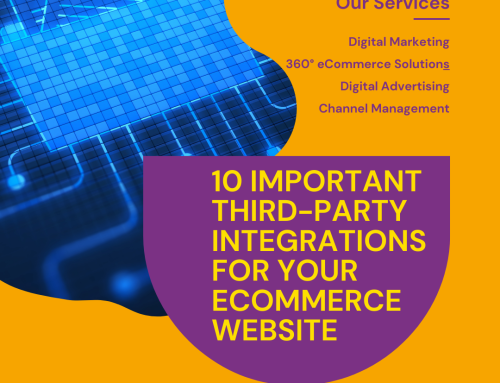In the fast-paced world of eCommerce, efficiency and seamless operations are crucial for success. Streamlining your business processes through seamless integrations can provide significant benefits, ranging from improved productivity to enhanced customer satisfaction.
Share This Story, Choose Your Platform!
In this blog post, we will explore the concept of seamless integrations in eCommerce and delve into the numerous advantages they offer.
What are Seamless Integrations?
Definition and Importance
Seamless integrations refer to the harmonious connection between different software applications and platforms within an eCommerce ecosystem. These integrations enable the smooth flow of data and information across systems, eliminating manual tasks, reducing errors, and enhancing overall operational efficiency.
The Importance of Seamless Integrations
Enhanced Efficiency:
By integrating various systems such as inventory management, order processing, and customer relationship management (CRM), businesses can streamline processes, eliminate duplicate data entry, and reduce human errors.
Improved Customer Experience:
Seamless integrations allow for a unified and personalized customer experience. Customer data can be shared seamlessly between systems, enabling tailored marketing campaigns, personalized recommendations, and responsive customer support.
Real-Time Insights:
Integrations provide real-time visibility into critical business information, such as inventory levels, sales data, and customer behavior. This enables informed decision-making, efficient inventory management, and effective marketing strategies.
Scalability and Flexibility:
As businesses grow, seamless integrations allow for easy scalability and adaptability. New systems and tools can be integrated seamlessly, ensuring a smooth transition and minimizing disruption.
Key Benefits of Seamless Integrations in eCommerce
Operational Efficiency and Productivity
Seamless integrations optimize business operations by automating manual tasks, reducing administrative workload, and minimizing human errors. This streamlines processes, improves productivity, and allows employees to focus on more strategic activities.
Accurate and Real-Time Data
Integrating systems eliminates data silos and ensures consistent and up-to-date information across platforms. Accurate and real-time data empowers businesses to make informed decisions, respond promptly to market changes, and provide reliable information to customers.
Streamlined Order Processing and Fulfillment
Seamless integrations enable efficient order processing, from capturing orders to fulfillment and shipping. Automated workflows, synchronized inventory management, and seamless communication with shipping providers result in faster order fulfillment, reduced errors, and improved customer satisfaction.
Enhanced Customer Experience and Personalization
Integrating CRM systems with eCommerce platforms allows businesses to gain a comprehensive view of customer interactions, preferences, and purchase history. This data enables personalized marketing campaigns, targeted promotions, and exceptional customer service, fostering long-term customer loyalty.
Simplified Inventory Management
Integrating inventory management systems with eCommerce platforms provides real-time visibility into inventory levels, product availability, and stock replenishment needs. Accurate inventory management minimizes stockouts, prevents overselling, and optimizes supply chain efficiency.
Key Seamless Integrations in eCommerce
Payment Gateway Integration
Seamless integration with payment gateways enables secure and convenient online transactions, offering customers a smooth checkout experience. This integration ensures payment data encryption, fraud prevention measures, and support for various payment methods.
CRM and Marketing Automation Integration
Integrating CRM systems with marketing automation platforms allows businesses to centralize customer data, automate marketing campaigns, and deliver personalized content. This integration enhances customer engagement, increases conversion rates, and fosters long-term customer relationships.
Inventory Management and Order Fulfillment Integration
Seamless integration between eCommerce platforms and inventory management systems automates inventory tracking, order fulfillment, and stock synchronization. This integration prevents stock discrepancies, optimizes inventory levels, and improves order accuracy and fulfillment speed, resulting in enhanced customer satisfaction.
Shipping and Logistics Integration
Integrating eCommerce platforms with shipping and logistics providers allows for seamless order fulfillment, real-time tracking, and automated shipping label generation. This integration streamlines the shipping process, reduces manual errors, and improves overall efficiency in delivering products to customers.
Customer Support and Helpdesk Integration
Seamless integration between eCommerce platforms and customer support or helpdesk systems enables efficient handling of customer inquiries, ticket management, and issue resolution. This integration centralizes customer support interactions, improves response times, and provides a seamless support experience.
Analytics and Reporting Integration
Integrating analytics and reporting tools with eCommerce platforms provides valuable insights into business performance, customer behavior, and marketing campaigns. This integration allows for data-driven decision-making, performance tracking, and identification of growth opportunities.
Best Practices for Implementing Seamless Integrations
Define Your Integration Goals and Requirements
Before implementing any integration, clearly define your business goals and identify the specific functionalities and improvements you aim to achieve. Assess your integration requirements and select solutions that align with your objectives.
Choose Reliable Integration Solutions
Research and choose reputable integration solutions that have a proven track record of successful implementations. Look for solutions that offer robust security measures, scalability, and compatibility with your existing systems.
Plan the Integration Process
Develop a comprehensive integration plan that outlines the steps, timeline, and responsibilities. Consider factors such as data migration, system compatibility, and potential disruptions during the integration process.
Test and Monitor Integration Performance
Thoroughly test the integration before fully deploying it. Monitor the performance of the integrated systems, ensuring data accuracy, seamless functionality, and optimal performance. Regularly review and update the integration as needed.
Conclusion
Seamless integrations play a vital role in streamlining eCommerce operations, improving efficiency, and enhancing the overall customer experience. By connecting various systems and platforms, businesses can optimize processes, leverage accurate data, and deliver exceptional service. Embracing seamless integrations empowers eCommerce businesses to stay competitive, scale effectively, and meet the evolving needs of their customers. Invest in the right integrations and unlock the full potential of your eCommerce store for long-term success.
Boost your eCommerce success with Purple Cow’s seamless integration solutions. Streamline your operations, enhance customer experience, and maximize efficiency. Our integrations connect your systems seamlessly, providing real-time data, streamlined order processing, and personalized marketing campaigns. From payment gateways to CRM and inventory management, Purple Cow has you covered. Stand out from the competition and take your eCommerce business to new heights with our seamless integration expertise.
Share This Story, Choose Your Platform!
In This Blog:

















